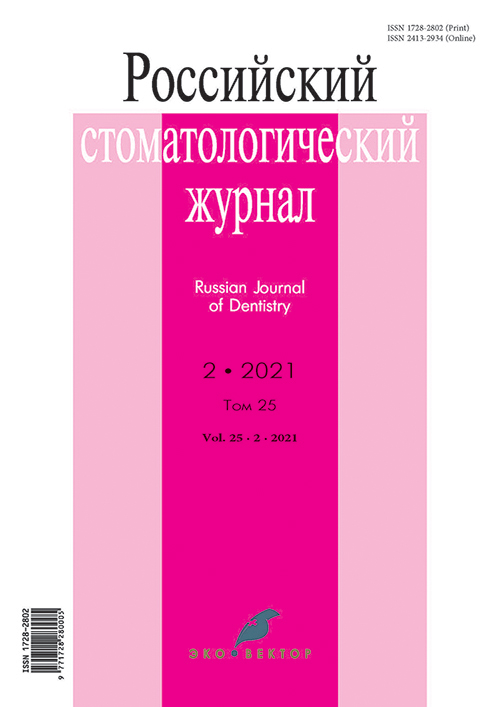Introduction of an integrated approach to the restoration of the occlusal surface of the crown part of the tooth with modern filling materials
- 作者: Vayts T.V.1
-
隶属关系:
- RUDN University
- 期: 卷 25, 编号 2 (2021)
- 页面: 127-135
- 栏目: Clinical Investigation
- ##submission.dateSubmitted##: 17.03.2022
- ##submission.dateAccepted##: 17.03.2022
- ##submission.datePublished##: 15.03.2021
- URL: https://rjdentistry.com/1728-2802/article/view/105046
- DOI: https://doi.org/10.17816/1728-2802-2021-25-2-127-135
- ID: 105046
如何引用文章
详细
BACKGROUND: The most frequently detected dental pathology, according to the World Health Organization (2019), is dental caries, since about 97% of the world’s population suffers from this disease. The most important factors in maintaining the health of the oral cavity and maintaining the necessary level of quality of life of a dental patient are the prevention and timely treatment of caries.
AIM: To develop a computerized technique for restoring the occlusal surface, taking into account the individual morphometric parameters of the patient’s dental crown. The task was to investigate the dimensional parameters, determine the presence and nature of the relationship between different morphometric indicators of the occlusal surface of teeth in caries-resistant men and women of young (18–35 years) age. Create an innovative computer program for the mathematical substantiation of the process of restoration of the occlusal surface of the tooth, taking into account the correlations between the morphometric parameters of the crown revealed in caries-resistant persons of young age.
MATERIAL AND METHODS: The objects of the study were: caries-resistant patients 82 people aged 18 to 35 years, male and female, and 106 patients, of different sex, who had carious lesions and complications of caries (pulpitis and periodontitis).
RESULTS: Based on the data obtained, an innovative program for calculating the dimensional characteristics of the occlusal surface of the teeth was developed (certificate of state registration of the computer program No. 2018611780 dated 02/07/2018) and introduced. At the end of the treatment with the use of the author’s and traditional methods of restoration of teeth, there is a positive dynamics of clinical indicators of the state of organs and tissues of the mouth.
CONCLUSION: The created innovative program for calculating the lost tissues of the occlusal surface of the tooth allows dentists to reconstruct the hard tissues of the teeth, taking into account the individual dimensional characteristics of the patient’s dentition, which helps to improve the quality of dental care to the population.
全文:
作者简介
Tatiana Vayts
RUDN University
编辑信件的主要联系方式.
Email: vayts_tv@pfur.ru
SPIN 代码: 3100-7936
аssistant of the department of therapeutic dentistry
俄罗斯联邦, 6, Miklukho-Maklay str, Moscow, 117198参考
- Lomiashvili LM, Ayupova LG, Pogadaev DV, Mikhailovskii SG. Iskusstvo modelirovaniya i restavratsii zubov. Omsk: Poligraf; 2014. (In Russ.).
- Omar D, Duarte C. The application of parameters for comprehensive smile esthetics by digital smile design programs: A review of literature. Saudi Dent J. 2018;30(1):7–12. doi: 10.1016/j.sdentj.2017.09.001
- Zanardi PR, Laia Rocha Zanardi R, Chaib Stegun R, et al. The Use of the Digital Smile Design Concept as an Auxiliary Tool in Aesthetic Rehabilitation: A Case Report. Open Dent J. 2016;10:28–34. doi: 10.2174/1874210601610010028
- Stafeev AA, Solov’ev SI, Hizhuk AV, Storozhenko VJ. Precision of chewing efficiency using a computer program “chewingview”. Sovremennaya ortopedicheskaya stomatologiya. 2017;(28):27–30. (In Russ).
- Gileva OS, Libik TV, Khalilaeva EV. Dental health in life quality criteria. Bashkortostan Medical Journal. 2011;6(3):6–11. (In Russ).
- Cervino G, Fiorillo L, Arzukanyan AV, et al. Dental Restorative Digital Workflow: Digital Smile Design from Aesthetic to Function. Dent J (Basel). 2019;7(2):30–42. doi: 10.3390/dj7020030
- Stephen J, Samuel Р. Diagnosis and treatment planning in dentistry. 3rd ed. Mosby; 2016.
- Abbas AT. Reconstruction skeleton for the lower human jaw using CAD/CAM/CAE. Journal of King Saud University — Engineering Sciences. 2012;24(2):159–164. doi: 10.1016/j.jksues.2011.10.003
- Dietschi D, Argente A. A comprehensive and conservative approach for the restoration of abrasion and erosion. part II: clinical procedures and case report. Eur J Esthet Dent. 2011;6(2): 142–159.
- Li RW, Chow TW, Matinlinna JP. Ceramic dental biomaterials and CAD/CAM technology: state of the art. J Prosthodont Res. 2014;58(4):208–216. doi: 10.1016/j.jpor.2014.07.003
- Martins AV, Albuquerque RC, Santos TR, et al. Esthetic planning with a digital tool: A clinical report. J Prosthet Dent. 2017;118(6):698–702. doi: 10.1016/j.prosdent.2017.02.016
- Vandenberghe B. The digital patient — Imaging science in dentistry. J Dent. 2018;74 Suppl 1:S21–S26. doi: 10.1016/j.jdent.2018.04.019
- Terry AD, Geller W. An esthetic and restorative dentistry: material selection and technique. London: Quintessence; 2013.
- Tahmaseb A, De Clerck R, Wismeijer D. Computer placement of implants: 3D planingsoftware, fixed inter-oral landmarks and CAD/CAM technology. Case history. Int J Oral Maxillofac Implants. 2009;24(3):541–546.
补充文件





















